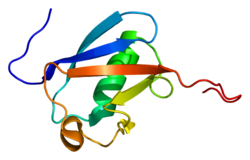OASL
OASL
Protein-coding gene in the species Homo sapiens
59 kDa 2'-5'-oligoadenylate synthetase-like protein is an enzyme that in humans is encoded by the OASL gene.[5][6]
| OASL | |||||||||||||||||||||||||||||||||||||||||||||||||||
|---|---|---|---|---|---|---|---|---|---|---|---|---|---|---|---|---|---|---|---|---|---|---|---|---|---|---|---|---|---|---|---|---|---|---|---|---|---|---|---|---|---|---|---|---|---|---|---|---|---|---|---|
 | |||||||||||||||||||||||||||||||||||||||||||||||||||
| |||||||||||||||||||||||||||||||||||||||||||||||||||
| Identifiers | |||||||||||||||||||||||||||||||||||||||||||||||||||
| Aliases | OASL, OASLd, TRIP-14, TRIP14, p59 p59-p592'-5'-oligoadenylate synthetase like, OASL1 | ||||||||||||||||||||||||||||||||||||||||||||||||||
| External IDs | OMIM: 603281 MGI: 2180849 HomoloGene: 2769 GeneCards: OASL | ||||||||||||||||||||||||||||||||||||||||||||||||||
| |||||||||||||||||||||||||||||||||||||||||||||||||||
| |||||||||||||||||||||||||||||||||||||||||||||||||||
| |||||||||||||||||||||||||||||||||||||||||||||||||||
| |||||||||||||||||||||||||||||||||||||||||||||||||||
| |||||||||||||||||||||||||||||||||||||||||||||||||||
| Wikidata | |||||||||||||||||||||||||||||||||||||||||||||||||||
| |||||||||||||||||||||||||||||||||||||||||||||||||||
2'-5'-oligoadenylate synthase is a protein family of structurally similar proteins, including OAS1, OAS2, and OAS3. However, mutations in the OAS domain mean it lacks the motif to allow oligomerization, preventing the synthesis of oligoadenylates. OASL, like the proteins of 2'-5'-oligoadenylate synthase family, is induced by interferons.
RNA Virus Infection
In RNA virus infection, viral genetic material binds to the RNA sensor RIG-I, triggering a reaction cascade that culminates in the secretion of type I interferons.[7] OASL acts as a sensitiser of RIG-I, binding to the caspase activation and recruitment domain and enhancing interferon production.[8]
DNA Virus Infection
While OASL has an anti-viral role in RNA viral infection, it has also demonstrated a pro-viral role in DNA viral infection.[9] OASL can bind to the viral DNA sensor cGAS, inhibiting its catalytic activity and preventing the secretion of interferons.[10]
Intracellular Bacterial Infection
OASL is shown to be upregulated during a wide variety of vacuolar and cytosolic bacterial infections.[11] It posesses an ability to inhibit autophagic mechanisms and antimicrobial peptide secretion within the host cell through unclear mechanisms, preventing clearence of the pathogen and creating a favourable intracellular environment.[12]
- "Human PubMed Reference:". National Center for Biotechnology Information, U.S. National Library of Medicine.
- "Mouse PubMed Reference:". National Center for Biotechnology Information, U.S. National Library of Medicine.
- Hovnanian A, Rebouillat D, Levy ER, Mattei MG, Hovanessian AG (May 1999). "The human 2',5'-oligoadenylate synthetase-like gene (OASL) encoding the interferon-induced 56-kDa protein maps to chromosome 12q24.2 in the proximity of the 2',5'-OAS locus". Genomics. 56 (3): 362–3. doi:10.1006/geno.1998.5737. PMID 10087211.
- Kell AM, Gale M (May 2015). "RIG-I in RNA virus recognition". Virology. 479–480: 110–121. doi:10.1016/j.virol.2015.02.017. PMC 4424084. PMID 25749629.
- Zhu J, Zhang Y, Ghosh A, Cuevas RA, Forero A, Dhar J; et al. (2014). "Antiviral activity of human OASL protein is mediated by enhancing signaling of the RIG-I RNA sensor". Immunity. 40 (6): 936–48. doi:10.1016/j.immuni.2014.05.007. PMC 4101812. PMID 24931123.
{{cite journal}}: CS1 maint: multiple names: authors list (link) - Choi, Un Yung; Kang, Ji-Seon; Hwang, Yune Sahng; Kim, Young-Joon (2015-03-06). "Oligoadenylate synthase-like (OASL) proteins: dual functions and associations with diseases". Experimental & Molecular Medicine. 47 (3): e144. doi:10.1038/emm.2014.110. ISSN 2092-6413. PMC 4351405. PMID 25744296.
- Rex, Viktoria; Stempel, Markus; Halle, Stephan; Brinkmann, Melanie M (2023). "The two faces of oligoadenylate synthetase-like: effective antiviral protein and negative regulator of innate immunity". Current Opinion in Virology. 60: 101329. doi:10.1016/j.coviro.2023.101329. PMID 37079941.
- Leisching G, Wiid I, Baker B (2017). "The Association of OASL and Type I Interferons in the Pathogenesis and Survival of Intracellular Replicating Bacterial Species". Front Cell Infect Microbiol. 7: 196. doi:10.3389/fcimb.2017.00196. PMC 5437694. PMID 28580319.
{{cite journal}}: CS1 maint: multiple names: authors list (link) - de Toledo-Pinto TG, Ferreira AB, Ribeiro-Alves M, Rodrigues LS, Batista-Silva LR, Silva BJ; et al. (2016). "STING-Dependent 2'-5' Oligoadenylate Synthetase-Like Production Is Required for Intracellular Mycobacterium leprae Survival". J Infect Dis. 214 (2): 311–20. doi:10.1093/infdis/jiw144. PMID 27190175.
{{cite journal}}: CS1 maint: multiple names: authors list (link)
- Mackay V, Linn S (1976). "Selective inhibition of the dnase activity of the recBC enzyme by the DNA binding protein from Escherichia coli". J. Biol. Chem. 251 (12): 3716–9. doi:10.1016/S0021-9258(17)33402-6. PMID 776974.
- Lee JW, Choi HS, Gyuris J, et al. (1995). "Two classes of proteins dependent on either the presence or absence of thyroid hormone for interaction with the thyroid hormone receptor". Mol. Endocrinol. 9 (2): 243–54. doi:10.1210/mend.9.2.7776974. PMID 7776974.
- Hartmann R, Olsen HS, Widder S, et al. (1998). "p59OASL, a 2'-5' oligoadenylate synthetase like protein: a novel human gene related to the 2'-5' oligoadenylate synthetase family". Nucleic Acids Res. 26 (18): 4121–8. doi:10.1093/nar/26.18.4121. PMC 147837. PMID 9722630.
- Rebouillat D, Marié I, Hovanessian AG (1998). "Molecular cloning and characterization of two related and interferon-induced 56-kDa and 30-kDa proteins highly similar to 2'-5' oligoadenylate synthetase". Eur. J. Biochem. 257 (2): 319–30. doi:10.1046/j.1432-1327.1998.2570319.x. PMID 9826176.
- Strausberg RL, Feingold EA, Grouse LH, et al. (2003). "Generation and initial analysis of more than 15,000 full-length human and mouse cDNA sequences". Proc. Natl. Acad. Sci. U.S.A. 99 (26): 16899–903. Bibcode:2002PNAS...9916899M. doi:10.1073/pnas.242603899. PMC 139241. PMID 12477932.
- Ota T, Suzuki Y, Nishikawa T, et al. (2004). "Complete sequencing and characterization of 21,243 full-length human cDNAs". Nat. Genet. 36 (1): 40–5. doi:10.1038/ng1285. PMID 14702039.
- Andersen JB, Strandbygård DJ, Hartmann R, Justesen J (2004). "Interaction between the 2'-5' oligoadenylate synthetase-like protein p59 OASL and the transcriptional repressor methyl CpG-binding protein 1". Eur. J. Biochem. 271 (3): 628–36. doi:10.1046/j.1432-1033.2003.03966.x. PMID 14728690.
- Gerhard DS, Wagner L, Feingold EA, et al. (2004). "The Status, Quality, and Expansion of the NIH Full-Length cDNA Project: The Mammalian Gene Collection (MGC)". Genome Res. 14 (10B): 2121–7. doi:10.1101/gr.2596504. PMC 528928. PMID 15489334.
- Scherer SE, Muzny DM, Buhay CJ, et al. (2006). "The finished DNA sequence of human chromosome 12". Nature. 440 (7082): 346–51. Bibcode:2006Natur.440..346S. doi:10.1038/nature04569. PMID 16541075.





